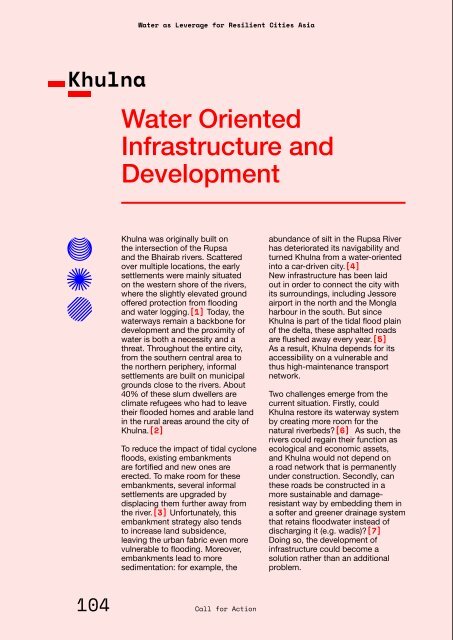Water as Leverage- Setting the scene for a call for action
- No tags were found...
Create successful ePaper yourself
Turn your PDF publications into a flip-book with our unique Google optimized e-Paper software.
<strong>Water</strong> <strong>as</strong> <strong>Leverage</strong> <strong>for</strong> Resilient Cities Asia<br />
Khulna<br />
<strong>Water</strong> Oriented<br />
Infr<strong>as</strong>tructure and<br />
Development<br />
[6]<br />
Khulna w<strong>as</strong> originally built on<br />
<strong>the</strong> intersection of <strong>the</strong> Rupsa<br />
and <strong>the</strong> Bhairab rivers. Scattered<br />
over multiple locations, <strong>the</strong> early<br />
settlements were mainly situated<br />
on <strong>the</strong> western shore of <strong>the</strong> rivers,<br />
where <strong>the</strong> slightly elevated ground<br />
offered protection from flooding<br />
and water logging.[1] Today, <strong>the</strong><br />
waterways remain a backbone <strong>for</strong><br />
development and <strong>the</strong> proximity of<br />
water is both a necessity and a<br />
threat. Throughout <strong>the</strong> entire city,<br />
from <strong>the</strong> sou<strong>the</strong>rn central area to<br />
<strong>the</strong> nor<strong>the</strong>rn periphery, in<strong>for</strong>mal<br />
settlements are built on municipal<br />
grounds close to <strong>the</strong> rivers. About<br />
40% of <strong>the</strong>se slum dwellers are<br />
climate refugees who had to leave<br />
<strong>the</strong>ir flooded homes and arable land<br />
in <strong>the</strong> rural are<strong>as</strong> around <strong>the</strong> city of<br />
Khulna.[2]<br />
To reduce <strong>the</strong> impact of tidal cyclone<br />
floods, existing embankments<br />
are <strong>for</strong>tified and new ones are<br />
erected. To make room <strong>for</strong> <strong>the</strong>se<br />
embankments, several in<strong>for</strong>mal<br />
settlements are upgraded by<br />
displacing <strong>the</strong>m fur<strong>the</strong>r away from<br />
<strong>the</strong> river.[3] Un<strong>for</strong>tunately, this<br />
embankment strategy also tends<br />
to incre<strong>as</strong>e land subsidence,<br />
leaving <strong>the</strong> urban fabric even more<br />
vulnerable to flooding. Moreover,<br />
embankments lead to more<br />
sedimentation: <strong>for</strong> example, <strong>the</strong><br />
abundance of silt in <strong>the</strong> Rupsa River<br />
h<strong>as</strong> deteriorated its navigability and<br />
turned Khulna from a water-oriented<br />
into a car-driven city.[4]<br />
New infr<strong>as</strong>tructure h<strong>as</strong> been laid<br />
out in order to connect <strong>the</strong> city with<br />
its surroundings, including Jessore<br />
airport in <strong>the</strong> north and <strong>the</strong> Mongla<br />
harbour in <strong>the</strong> south. But since<br />
Khulna is part of <strong>the</strong> tidal flood plain<br />
of <strong>the</strong> delta, <strong>the</strong>se <strong>as</strong>phalted roads<br />
are flushed away every year.[5]<br />
As a result, Khulna depends <strong>for</strong> its<br />
accessibility on a vulnerable and<br />
thus high-maintenance transport<br />
network.<br />
Two challenges emerge from <strong>the</strong><br />
current situation. Firstly, could<br />
Khulna restore its waterway system<br />
by creating more room <strong>for</strong> <strong>the</strong><br />
natural riverbeds?[6] As such, <strong>the</strong><br />
rivers could regain <strong>the</strong>ir function <strong>as</strong><br />
ecological and economic <strong>as</strong>sets,<br />
and Khulna would not depend on<br />
a road network that is permanently<br />
under construction. Secondly, can<br />
<strong>the</strong>se roads be constructed in a<br />
more sustainable and damageresistant<br />
way by embedding <strong>the</strong>m in<br />
a softer and greener drainage system<br />
that retains floodwater instead of<br />
discharging it (e.g. wadis)?[7]<br />
Doing so, <strong>the</strong> development of<br />
infr<strong>as</strong>tructure could become a<br />
solution ra<strong>the</strong>r than an additional<br />
problem.<br />
[7]<br />
[2]<br />
[5]<br />
[3]<br />
[4]<br />
104 Call <strong>for</strong> Action<br />
PART 1 / From Global <strong>Water</strong> Issues to a Call <strong>for</strong> Action<br />
[1]<br />
105


















